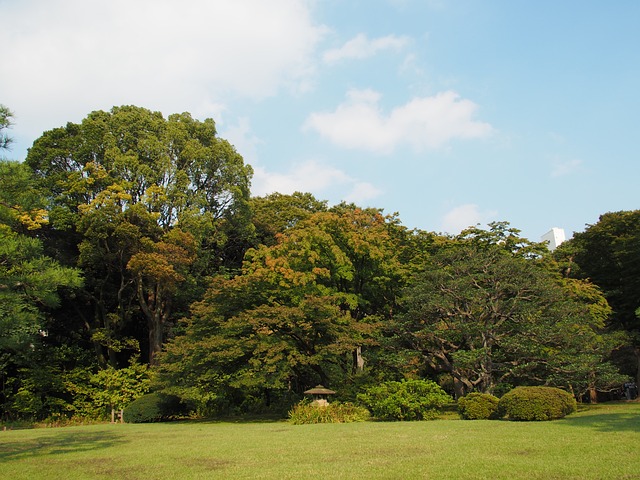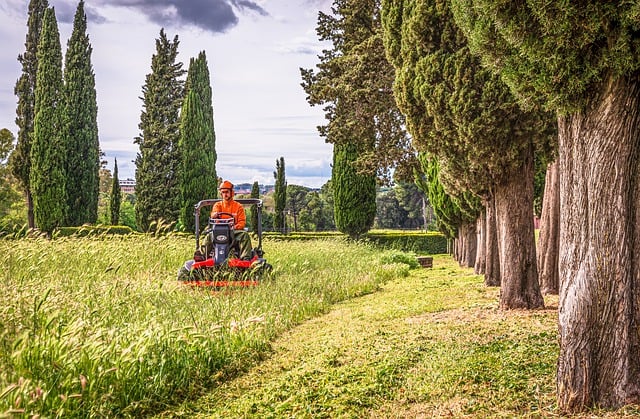Effective lawn care and landscaping hinge on the regular application of mulch to improve soil quality, retain moisture, and suppress weeds, while edging clearly defines garden bed and pathway boundaries, enhancing your lawn's aesthetic appeal and facilitating maintenance. Mulching with either organic materials like wood chips or inorganic options such as stones or rubber nuggets helps maintain the health of your turf by preventing overgrowth into non-turf areas. Edging tools, whether manual or powered, help create sharp, clean lines that define and separate different landscaping elements. Combining mulching with precise edging not only leads to a more visually appealing lawn but also promotes the health of your grass by preventing it from overextending into inappropriate spaces. This holistic approach to lawn care and landscaping ensures a lush, well-maintained yard that stands out as a highlight of your property, aligning with best practices for sustainable outdoor upkeep.
Maintaining a lush, vibrant lawn is a testament to a gardener’s skill, and mastering the techniques of mulching and edging are key elements in this endeavor. This article delves into the nuances of lawn care and landscaping, offering insights on how these practices can significantly improve your grass’s health and your property’s curb appeal. We will explore the transformative impact of mulch as a soil amender and its role in moisture retention and weed suppression. Additionally, we will guide you through the process of precise edging to define lawn borders, creating a sharp contrast between the green expanse and garden or hardscape areas. By integrating these techniques, your landscaping efforts will not only enhance aesthetic value but also promote a robust soil environment for your lawn.
- Understanding the Role of Mulching in Optimal Lawn Care and Landscaping
- Mastering the Art of Edging for a Neat and Manicured Lawn in Lawn Care and Landscaping Practices
- Combining Mulch and Edging Techniques for Enhanced Lawn Health and Aesthetic Appeal in Your Landscaping Efforts
Understanding the Role of Mulching in Optimal Lawn Care and Landscaping

Mulching plays a pivotal role in effective lawn care and landscaping practices, contributing to soil health, conserving moisture, and regulating temperature. When organic materials such as grass clippings, leaves, or wood chips are applied as mulch on lawns, they decompose over time, enriching the soil with essential nutrients that support vigorous plant growth. This process not only improves the soil’s structure but also aids in maintaining an optimal moisture level, reducing the need for frequent watering and conserving precious water resources. Additionally, mulching helps to suppress weeds by creating a barrier between the soil and the sunlight, making it harder for weeds to germinate and grow. By incorporating mulch into your lawn care routine, you can create a healthier, more resilient lawn that requires less maintenance and contributes positively to the overall landscaping aesthetic.
Incorporating edging around garden beds or pathways in conjunction with mulching can further enhance the appearance of your yard while delineating distinct areas within your landscape design. Edging helps prevent grass from encroaching onto walkways or bed spaces, maintaining a clean, manicured look that is characteristic of well-maintained lawns and landscapes. This demarcation not only promotes a clear boundary but also facilitates more efficient lawn care tasks such as mowing, trimming, and applying mulch. By combining thoughtful edging with strategic mulching, homeowners can achieve a harmonious outdoor space that is both visually appealing and ecologically beneficial to their lawn’s health and longevity.
Mastering the Art of Edging for a Neat and Manicured Lawn in Lawn Care and Landscaping Practices

Mulching is a cornerstone of effective lawn care, but it complements well with the practice of edging. Both techniques enhance the aesthetic appeal and health of your lawn, creating a clear distinction between your greenery and garden beds or hardscapes like sidewalks and driveways. Edging serves to define the edges of your lawn sharply, which not only improves the visual presentation of your landscape but also prevents grass from overtaking areas where it’s not wanted. A clean edge ensures that maintenance tasks are more manageable and the lawn looks neat and manicured. When edging, it’s important to use the right tools and techniques; gas-powered edgers or manual hand tools can be employed depending on the size of your yard and your preference for power or manual labor. After edging, the soil around the edges is often exposed, and this is where mulching plays a pivotal role in landscaping practices. A layer of mulch helps to retain moisture, suppress weeds, and maintain soil temperature, all of which are conducive to a healthy lawn. The choice of mulch material can vary from organic options like wood chips or straw to inorganic materials like rubber or lava rock. Each type of mulch has its benefits and drawbacks, so select one that best suits your specific needs and the overall landscape design. Regular edging and strategic mulching contribute significantly to a well-maintained lawn that stands out for its beauty and health. Remember to integrate these practices into your routine lawn care and landscaping schedule for optimal results.
Combining Mulch and Edging Techniques for Enhanced Lawn Health and Aesthetic Appeal in Your Landscaping Efforts

Incorporating mulching and edging into your lawn care routine can significantly enhance both the health and aesthetic appeal of your landscape. Mulching serves a dual purpose: it retains soil moisture by preventing evaporation and acts as a barrier against weeds that compete with your turf for nutrients and sunlight. When applying mulch, ensure it is evenly distributed around plants and trees to create a clear demarcation between the lawn and garden beds. This not only improves the visual contrast but also helps in maintaining clear edges where the grass meets other plantings, which is essential for a neat appearance. The choice of mulch material can also influence its effectiveness; organic options like wood chips or straw break down over time to enrich the soil, while inorganic mulches like stones or rubber nuggets offer a more long-lasting solution with less need for frequent replacement.
Edging is another critical aspect of lawn care that complements mulching by defining clear boundaries of your lawn. A well-defined edge can prevent grass from encroaching onto paths, driveways, or flower beds, maintaining the clean lines that contribute to a polished look in your landscape. Edging tools like spades, half-moon edgers, or battery-operated edgers can efficiently create crisp lines between different areas of your yard. Combining regular mulching with precise edging not only enhances the visual appeal but also promotes healthier lawn growth by minimizing grass overgrowth into unsuitable areas and reducing maintenance time and effort. Both practices are integral to effective lawn care and landscaping, ensuring that your outdoor space remains both vibrant and well-maintained throughout the growing season.
Lawn Care and Landscaping practitioners recognize the significance of integrating mulching and edging for a thriving, well-maintained lawn. These practices not only bolster the health of the turf but also elevate its visual appeal. By understanding the nuances of mulch application, as detailed in “Understanding the Role of Mulching in Optimal Lawn Care and Landscaping,” lawn enthusiasts can effectively regulate soil moisture, suppress weeds, and enrich the organic matter content. Meanwhile, the guidance provided in “Mastering the Art of Edging for a Neat and Manicured Lawn in Lawn Care and Landscaping Practices” offers a clear path to achieving clean, defined lawn edges that enhance curb appeal and maintenance efficiency. The synergy between these two techniques, as explored in “Combining Mulch and Edging Techniques for Enhanced Lawn Health and Aesthetic Appeal in Your Landscaping Efforts,” further underscores the importance of a comprehensive approach to lawn care and landscaping. Homeowners and professionals alike can reap the benefits of a healthier, more beautiful lawn by embracing these strategies as part of their routine lawn care and landscaping regimen.
